Dunlop Precision 100 Tour Racquet Review
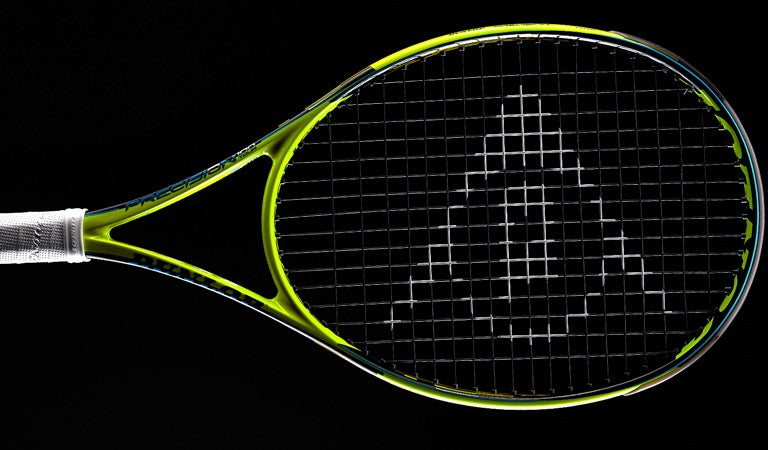
Upsides
- Good access to spin
- Easy to swing
- Good blend of power and control
Downsides
- Stiff feel
Summary
Dunlop broadens its racquet lineup by launching the Dunlop Precision 100 Tour, a modern player's frame with exceptional maneuverability and accuracy. New to the Precision line of racquets, Dunlop's Hybrid Beam Construction combines a rounded aero beam shape (for speed and power) with a more traditional box beam (for better control and feel). Although our playtesters found the feel to be on the stiff side, the Precision 100 Tour has SRX Shock Reduction and Parallel Drilling technologies to reduce extra vibrations. The playtesters had mixed feelings throughout the playtest, but they all found found excellent maneuverability and spin potential. Some playtesters preferred the Precision 100 Tour from the baseline, noting the favorable pace, spin and control, while others liked to approach the net quickly to finish off points. Ultimately, all of our playtesters were able to find something that worked for their games. Players looking for a modern, fast swinging high performance racquet should definitely check out the Precision 100 Tour.
Dunlop Precision 100 Tour Racquet Scores
| Power | 81 |
| Control | 78 |
| Maneuverability | 85 |
| Stability | 77 |
| Comfort | 65 |
| Touch/Feel | 72 |
| Serves | 80 |
| Groundstrokes | 78 |
| Returns | 76 |
| Slice | 76 |
| Topspin | 80 |
| Volleys | 82 |
| Overall | 76 |
Groundstrokes - Score: 78
Our playtesters found some positives and some negatives when swinging the Dunlop Precision 100 Tour from the baseline. Mark was not aware of the specs for the new Dunlop Precision 100 Tour before playing with it, but they quickly became clear once he was on the court. "From maybe the 10th swing on, I knew two things: The new Dunlop Precision 100 Tour weighed over 11 oz, and I loved it from the baseline," Mark began. "As usual, I bring other racquets to the court when I'm testing a new racquet -- just in case I am drowning with one, so to speak. Within 10 minutes of hitting from the baseline with the Precision 100 Tour I was confident that I would not need or want to switch racquets. The racquet I played with was paired with a full bed of a polyester string, and with this combination I was able to hit my targets with loads of spin, along with good pace. One of the aspects I most noticed from the baseline, and benefited from, was how well I could vary and control the ball's height over the net. This contributed to a higher number of my shots landing where I intended."
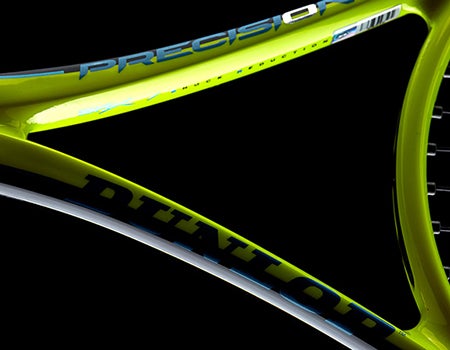
Hannah found the Dunlop Precision 100 Tour to be one dimensional from the baseline, saying, "When I tried to mix up the trajectory or spin levels of my groundstrokes I started to launch the ball past the baseline. The sweetspot was unpredictable, and the feel of the racquet was extremely brassy. I was hoping to take advantage of the string pattern and maneuverable specs, but after drilling for a bit I was still struggling to adjust. I was really having trouble with this when I was on the run, and it caused me to suppress some aspects of my groundstroke game and stick to a simple rally ball instead."
Tiffani really found a groove with this Precision 100 Tour from the baseline. She said, "I felt consistent off the ground and executed my game well, which meant I was moving the ball around to get my opponent running. The specs of the racquet are right where I like them, so I felt confident and comfortable playing points pretty much right off the bat. I found the most success sitting tight and playing my counter-punching game. When I tried to force the issue my shots tended to fly. Even though I was pleased overall with how I played with this racquet from the baseline, I struggled with the comfort. Initially, the test racquet was strung with Dunlop Silk, which I thought would have offered a softer feel because it's a multifilament string, but my wrist was sore for days because of the stiff-to-brassy feel. Later it was strung with Luxilon ALU Power, which surprisingly softened the feel, although the comfort level still wasn't quite where I wanted it. If I could find a string setup to improve the comfort of this racquet, I would consider it a winner for me because I played well with it."
Jason took full advantage of this racquet's fast swing. He noted, "Because I could generate racquet head speed effortlessly I was able to put more spin and power on my shots. The Precision 100 Tour lacked stability because there isn't much weight in the hoop, and I struggled with countering the shots of bigger hitters. If I was going to keep using it I would definitely add some tungsten tape to the head to shore that up. I think the Precision 100 Tour actually plays pretty well and is user friendly from the baseline, but the big negative for me isn't the playability, it's the feel. It has a brassy, tinny and stiff feel that took its toll on my wrist and elbow after extended use."
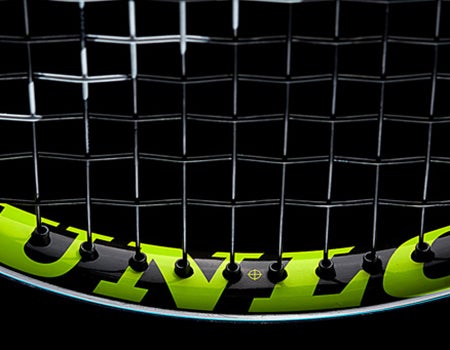
Volleys - Score: 82
The Dunlop Precision 100 Tour offered a fast response up at net. However, some playtesters were left wanting a little more stability. Although not a fan of the overall feel of the racquet, Hannah said, "I did really like the results I had at net. It was stable and quick, and when I was prepared for the shot my volleys never landed short. This racquet really allowed me to focus on getting my legs into my volleys, which I enjoyed."
Tiffani didn't enjoy her time at the net with the Precision 100 Tour, saying, "It didn't feel like the Precision 100 Tour was unstable when I was hitting from the baseline, but when I moved forward it was twisting when I hit off center. I do think that the strings amplified the issue, and with a more comfortable sting setup I would feel better volleying with this racquet."
Mark was just as pleased with the Dunlop Precision 100 Tour at net as he was at the baseline, "This was another portion of the playtest where I was very effective with the Dunlop Precision 100 Tour. I was in control anywhere near the net. I might assign some credit to the string pattern. The ball jumped off the 16x19 stringbed in a predictable manner. It was not until passing shot speeds exceeded 75 MPH that I felt any instability from the Precision 100 Tour. And at my level of play I don't encounter too many players who can consistently hit with that sort of pace from the baseline."
Jason found the racquet to be hot and cold when he was at the net. He explained, "I was rewarded with decent power and good control when the ball did hit the sweetspot. The racquet's playability suffered if the ball missed the sweetspot when I was reaching out wide for a volley. A little bit of weight would go a long way here."

Serves - Score: 80
The TW playtesters had mixed results serving with the Precision 100 Tour. Jason's serves seemed to have some nice pop to them. He said, "The lack of plow through wasn't nearly as noticeable here as it was on groundstrokes, and I could generate pace with ease because of how fast I could accelerate the racquet. Additionally, I was very happy with the spin I was putting on the ball."
Mark was confident enough with the Dunlop Precision 100 Tour from the baseline and net, so he predicted this would carry over to his serve. He said, "It did! When the Precision 100 Tour was matched with a firm polyester stringbed I was able to effectively serve to either side of the box, setting me up for quite a few cheap points."
Hannah felt that power was lacking on her serves with the Dunlop Precision 100 Tour. She said, "I did find my targets when serving with this racquet. There was an unexpectedly precise response on my serves. However, serving with the racquet was very hard on my arm, making it hard to amp up my swingd speed. Although it was precise, I wouldn't be confident with it in a match without a lengthy adjustment period."
Tiffani struggled to find her range when serving with the Precision 100 Tour. She said, "I preferred hitting flat serves with this racquet, and my serve speeds were average to slightly above average. I tried to add more arc and spin to my second serves and I struggled in a couple of different ways. When I tried to add the extra spin I lost power. I also felt like I had to exaggerate my follow through on my second serve or the ball would fly long."
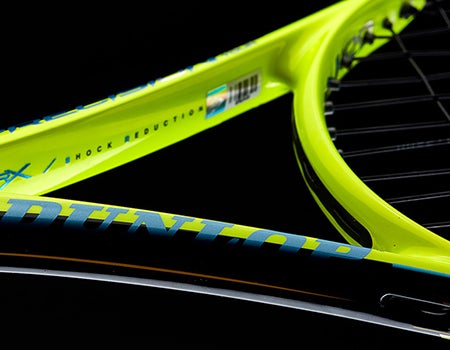
Returns - Score: 76
The TW playtesters enjoyed the fast feel of the Dunlop Precision 100 Tour when returning serve, but some of them struggled to find their groove. "This racquet played a lot lighter on returns than I thought it would with an 11.5 oz weight," Tiffani said. "I would have liked more weight in the head when I was returning for added stability. I could feel the racquet torque, and I felt a lot of that in my wrist. On the flip side, I liked how easily this racquet came through the strike zone, and I could hit returns with good depth when I took a fuller swing on my returns."
"The Precision 100 Tour was solid on the return if I was facing a player who wasn't serving with a ton of pace," Jason commented. "I could swing out and be aggressive, knowing how whippy the racquet was and how much spin I could put on my shot. The racquet's lack of weight/swingweight was exposed when I was trying to return a big hitter's serve. Mis-hit shots didn't just fall short, they were also quite jarring on my arm."
Dunlop's newest Precision 100 Tour benefited Mark's game all-around, including his return of serve. He said, "I was able to drive the ball effectively off the backhand wing, flat or with slice, and even my forehand 'squash shot' return was helped a little."
"Like my groundstrokes, my returns tended to launch off my strings," Hannah said. "I could hit an average return no problem, but I had little connection to the ball and very little confidence when it came to mixing it up."
Overall - Score: 76
| Technical Specifications | ||
|---|---|---|
| Length | 27 in | 69 cm |
| Head Size | 100 sq in | 645 sq cm |
| Weight | 11.5 oz | 326 gm |
| Balance Point | 12.59 in 32 cm | 7pts Head Light |
| Construction | 22mm/ 22mm/ 22mm | |
| Composition | Graphite | |
| String Pattern | 16 Mains / 19 Crosses | |
| Babolat RDC Ratings | ||
|---|---|---|
| Score | Grade | |
| Flex Rating | 66 | Range: 0-100 |
| Swing Weight | 307 | Range: 200-400 |
| Mark's Scores | |||
|---|---|---|---|
| Power | 9 | Serves | 8.5 |
| Control | 9 | Groundstrokes | 9 |
| Maneuverability | 8.5 | Returns | 8.5 |
| Stability | 9 | Slice | 8.5 |
| Comfort | 7.5 | Topspin | 9 |
| Touch/Feel | 8.5 | Volleys | 9 |
| Overall | 9 | ||
| Jason's Scores | |||
|---|---|---|---|
| Power | 7.2 | Serves | 8.1 |
| Control | 8 | Groundstrokes | 8 |
| Maneuverability | 9 | Returns | 8 |
| Stability | 7 | Slice | 7.8 |
| Comfort | 6.3 | Topspin | 8.4 |
| Touch/Feel | 7.7 | Volleys | 7.9 |
| Overall | 7.1 | ||
| Hannah's Scores | |||
|---|---|---|---|
| Power | 8 | Serves | 7.5 |
| Control | 6 | Groundstrokes | 6 |
| Maneuverability | 7.6 | Returns | 6 |
| Stability | 7 | Slice | 6 |
| Comfort | 5 | Topspin | 6 |
| Touch/Feel | 5 | Volleys | 8 |
| Overall | 6.3 | ||
| Tiffani's Scores | |||
|---|---|---|---|
| Power | 8 | Serves | 7.7 |
| Control | 8.3 | Groundstrokes | 8.3 |
| Maneuverability | 8.8 | Returns | 7.9 |
| Stability | 7.7 | Slice | 7.9 |
| Comfort | 7 | Topspin | 8.4 |
| Touch/Feel | 7.5 | Volleys | 7.7 |
| Overall | 7.8 | ||
Playtester Profiles
Mark: 5.0 lefty all-court player with a one-handed backhand. He currently plays with the Babolat Pure Aero Tour.
Jason: 4.0 baseliner with a semi-western forehand and two-handed backhand. Currently using a Babolat Pure Strike 16x19 (Project One7).
Hannah: Open level player with a semi-western forehand and two-handed backhand. She currently plays with the Babolat Pure Strike 16x19 (Project One7).
Tiffani: 4.0 level baseliner with a semi-western grip on the forehand and hits a two-handed backhand. Currently playing with the Prince Textreme Tour 100P.

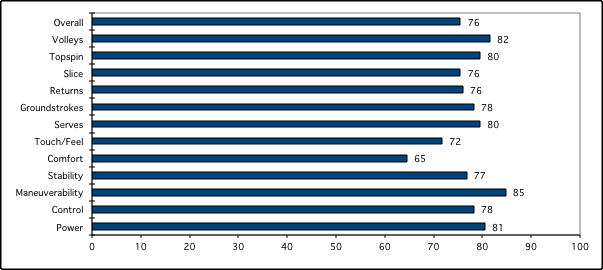






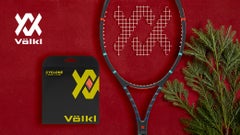




Likes
Mark - "The Precision 100 Tour has a firm, but not stiff, layup of graphite, giving it more of a traditional frame feel rather than the stiffer modern frame feel. Another thing worth mentioning is the 16x19 string pattern, more specifically, the string spacing. The Precision 100 Tour features a spacing that creates squares (close to that shape), whereas the spacing on many other racquets have a more rectangular shape. For whatever reason, the square pattern complements my swing better."
Hannah - "It was easy to achieve depth on my volleys, which made the Precision 100 Tour a great tool at the net."
Tiffani - "The Precision 100 Tour has good all-around playability. I could play a steady baseline game with this racquet because of the control, and it was very maneuverable."
Jason - "The Precision 100 Tour has a very fast feel and is easy to swing. Great access to spin. Good power for its weight."
Dislikes
Mark - "Nothing."
Hannah - "It had an extremely brassy feel from all areas of the court, making it hard for any shot to feel comfortable. It's one dimensional and lacks control from the baseline."
Tiffani - "Comfort was lacking."
Jason - "Super brassy and stiff feel. It can get pushed around because of the lack of weight in the hoop."
Comparing the racquet to others they've tried, our testers said:
Mark - "I would compare the new Dunlop Precision 100 Tour with the Wilson Pro Staff 97, Pro Staff 97S and Burn FST 99, the Yonex VCORE Duel G 97 (310g), VCORE SV 98 and EZONE DR 98, and the newer Babolat Pure Strike 16x19."
Hannah - "I can't compare this to any Dunlop racquet. However, in its weight range this racquet is a lot less comfortable and has less control than comparable racquets. The brassy, harsh feel was the complete opposite of some of the dampened and muted options available, and it even caused some arm soreness."
Tiffani - "The head size, weight and balance of the Precision 100 Tour are the same as my racquet of choice, the Prince Textreme Tour 100P. I play well with both racquets, but I find I can be a little more aggressive consistently with the Textreme Tour 100P. The biggest thing, however, is comfort. The Prince racquet just feels softer."
Jason - "The playability of the Precision 100 Tour reminds me a lot of the Tecnifibre TFight DC 305. Even though the static weight is where I want it to be in both racquets, I'd add weight to the hoop to up the swingweight."